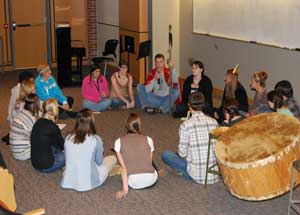Editorial
Front Page - Friday, December 4, 2009
UTC students learn hands-on with Law & Order: Native American
Samara Litvack

As the old saying goes, give a man a fish; he will eat for a day. Teach him to fish; he will eat for a lifetime. In an interactive approach to Introduction to Anthropology and Sociology courses, two professors at the University of Tennessee-Chattanooga are putting the old adage to good use in their classrooms.
When Dr. Lyn Miles, professor of anthropology, got to the Native American portion of her Anthropology 152 class, she decided to teach her students in a way that would leave an impression on them. Rather than the standard lecture style popular in so many classrooms, students in this class had the opportunity to earn credit by organizing a “Turtle People Talking Circle,” in which they replicated the methods many Native Americans and First Nations of Canada use in lieu of court systems to deal with criminal matters and community disputes.
“What we’re really wanting to do is not just have the students read books and study lectures, but to actually experience and participate and create something themselves,” Miles said. “They might forget chapter 23 but they’re never going to forget the talking circle.”
Dr. Shela Van Ness also participated, bringing in her sociology students to study the ways in which Miles’ students put together their performance.
“Tribe members” entered Benwood Auditorium on Nov. 12 to the slow, steady beat of a drum to discuss a crime that had been committed: manslaughter. First entered the medicine healer, then the mothers of each of the four clans. After saying traditional blessings, the tribe sat in a talking circle and began passing the talking stick, which gave its holder the power to speak.
As instructed by the Bear Clan mother, played by Van Ness, the discussion began with “the person whose sorrow may be the greatest” – the offender.
The female explained her story, that she had been arguing with her boyfriend when she accused him of not fulfilling his duties that day. He became angry with her, she said, and yelled in her face with words that made her very uncomfortable. When she pushed him away, he tripped on a rock. Although she did not want him to die, she could not save him and immediately began praying to the Great Spirit for forgiveness. In the talking circle, she wished aloud for peace to be restored among the tribe.
As the class passed the talking stick – from her family, to outside members of the tribe, to the victim’s family – each explained how he or she knew the victim and the offender. There were mothers, fathers and cousins; friends of both sides; a medicine healer; a physician; the general store owner and a local merchant; the tribe’s hunter; and two shepherds. Each member knew both victim and offender and spoke of being deeply saddened by the experience. Each member also expressed the common goal of restoring peace within the tribe.
After one round of discussion, the victim’s mother requested control of the talking stick by making a very discreet gesture – something common in Native American and First Nations of Canada culture – and expressed her original desire for revenge upon hearing what had happened to her son. She showed members of the tribe a photo of the deceased and a toy he played with as a child.
“He was my only son and I really don’t know what to do with my life anymore,” she said. “All I want is for harmony to be restored and just to feel better about this.”
The victim’s father then took the stick, expressing sadness about having no one left to carry on his family name. His son hunted like no other, he said, and his death was a great loss to the family and to the entire tribe.
Again, the talking stick was passed around the circle and tribe members began offering suggestions about ways to heal their wounds. The offender’s brother suggested hosting a feast to honor the deceased’s life. The victim’s mother admitted she shared the same pain and suffering as the offender, and eventually agreed that a feast, to be prepared by the offender, was indeed the best way to honor her son’s memory.
After the victim’s father and mother, as well as all other members of the tribe, settled on this resolution, the talking stick was again passed around the circle. Since everyone was in agreement, no one spoke. When the talking stick made its way completely around, each member of the tribe stood and placed a hand on it, signifying their resolution.
The offender then offered the victim’s mother gifts she had made – a turtle drum and a silver bell – as peace offerings, in hopes to begin healing the tribe’s wounds.
Talking circles often take the place of trial and sentencing among Native American and First Nations of Canada tribes. Unlike the U.S. legal system, which focuses on crime and punishment, the goal is for the community as a whole to heal and rebalance itself and bring the offender back into the tribe as a productive member, while also holding him or her responsible.
Both Miles and Van Ness are of part-Native/First Nations descent (Coast Salish of British Columbia; Cree of Montana; and Abenaki/Wabanaki of Vermont and Quebec).
|
|